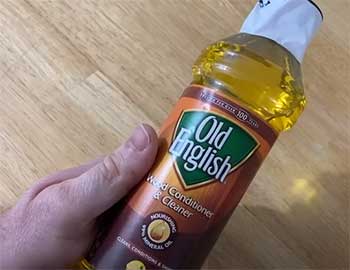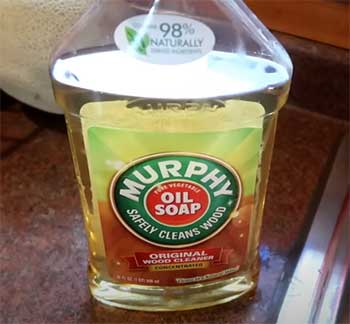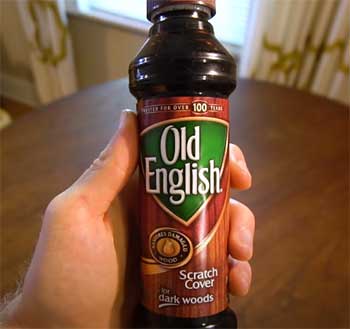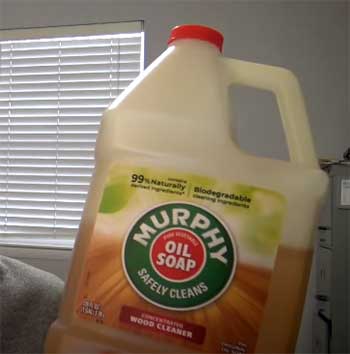Furniture care is an important part of maintaining your home. Using the right products can keep your furniture looking its best for years to come. Two popular options for cleaning and conditioning wooden furniture are Old English and Murphy’s Oil Soap.
But which one is better for your needs?
Here is an in-depth comparison of Old English and Murphy’s Oil Soap to help you decide.
A Brief Comparison Table
| Aspects | Old English | Murphy’s Oil Soap |
| Cleansing Ingredients | Mineral spirits, lemon oil | Plant-based oils |
| Conditioning Ingredients | Lemon oil, carnauba wax | Plant-based oils |
| Cleaning Power | Stronger, cuts through grease and wax buildup | Gentler, requires more scrubbing |
| Wood Protection | Wax provides a protective coating | No wax, so no long-term barrier |
| Application Method | Spray, liquid, wipes | Liquid concentrate to dilute |
| Ease of Use | Very easy, spray and wipe | Requires more effort to dilute and rinse |
| Best For | Finished wood with existing top coat | Unfinished, painted, antique wood |
| Environmental Impact | Harsher chemicals like mineral spirits | Plant-based, biodegradable |
| Cost | $3 to $8 for 16 to 24oz | $3 to $6 for 16 to 24oz |
Overview of Old English
Old English furniture polish has been around for over 50 years. It is specially formulated for cleaning, polishing and protecting wood surfaces.
Some key features of Old English:

- Cleans away dirt, grime and fingerprints
- Contains natural oils that enhance and restore wood’s natural beauty
- Leaves behind a protective coat of lemon oil to condition the wood
- Available as an aerosol spray, liquid and wipe
- Safe for use on finished wood, French polished antiques, lacquered surfaces and more
The active ingredients in Old English are mineral spirits to cut through grease and dirt, lemon oil to condition the wood, and carnauba wax to provide a protective coating. It does contain some chemicals like glycol ether that help dissolve grime.
Old English is easy to apply. Simply spray or wipe a small amount on the surface and wipe off. It cleans and polishes in one easy step. The lemon oil nourishes the wood while the wax fills in micro-scratches and crevices to make the wood look its best.
Overview of Murphy’s Oil Soap
Murphy’s Oil Soap is another long-standing brand that has been available since the early 1900s. It is made from plant-derived oils and is designed to clean wooden surfaces gently but effectively.
Here are some of the key qualities of Murphy’s Oil Soap:

- Formulated with coconut, palm and sunflower oils
- Lifts away dirt, grime and old wax buildup
- Contains no harsh chemicals, acids or bleach
- Safe for finished and unfinished wood, painted surfaces
- Available as liquid concentrate, spray and wipes
- Leaves behind a clean, conditioned surface
The main cleansing ingredients in Murphy’s Oil Soap are the plant-derived oils.
Additional ingredients like sodium carbonate and citric acid help to lift dirt and neutralize greasy residue.
To use Murphy’s Oil Soap, dilute it in water per the instructions, apply it to the wood surface with a cloth or sponge, allow it to soak in briefly and wipe clean. It takes a bit more elbow grease than Old English but leaves the wood fresh and conditioned without a greasy feel.
Key Differences Between Old English And Murphy’s Oil Soap
- Comparing the Cleaning Ability
One of the main differences between these two products is the cleaning power.
Old English contains mineral spirits, which are quite effective at cutting through grease, dirt, grime and wax buildup on wooden furniture. The spray application allows the formula to penetrate into crevices. It wipes away easily, providing a deep clean.
Murphy’s Oil Soap relies on plant-based oils to clean away dirt and grime. It may require more scrubbing to lift away stubborn residue. However, it can be safely used on unfinished and painted wood without worrying about damage. The liquid concentrate dilution allows you to control the strength as needed.
Both products will get your wood surfaces clean, but Old English provides a bit more heavy duty cleaning power on finished wood when grease and wax need to be removed. Murphy’s is gentler if you have painted or raw wood.
- Comparing the Conditioning Benefits
In addition to cleaning, these products also condition and protect the wood. There are some clear differences in the way they work.
Old English contains both lemon oil and carnauba wax. The lemon oil penetrates into the wood grain to nourish and moisturize the cells of the wood. This helps restore luster and prevent the wood from drying out. The wax fills in tiny abrasions and coats the surface to provide lasting protection.
Murphy’s Oil Soap contains no wax, but relies on the natural oils to condition the wood. The oils soak into the wood fibers to keep the wood from drying out or becoming brittle. It does not offer the longer term protective barrier that Old English’s wax provides.
If your goal is to both clean and condition, Old English provides that nice one-two punch. Murphy’s will condition the wood after cleaning but does not offer as much prolonged protection with its oil-only formula.
- Ease of Use Comparison
When it comes to convenience, there are some differences in how easy these products are to use on wood furniture.

Old English is available as an aerosol spray, liquid and disposable wipes.
The spray makes application very simple – just spray a light coat directly onto the furniture, let it sit briefly and wipe away.
The disposable wipes allow you to quickly dust and shine without liquids.
Murphy’s Oil Soap requires a bit more effort. The liquid concentrate needs to be diluted in water before use.
This means an extra mixing step before cleaning your furniture.
It also requires a bit more scrubbing and rinsing to remove residue after cleaning. The wipes are convenient but will still require some buffing to make the wood shine.
For quick routine cleaning and polishing, Old English offers more convenience in application. Murphy’s Oil Soap is better suited when you need to do a deeper periodic cleaning session and don’t mind the extra effort.
- Effect on Different Wood Types
Keep in mind that wood comes in many varieties, finishes and ages. This can impact how well these products work.
Old English works well on most finished wood with an existing top coat of varnish, polyurethane or lacquer. The mineral spirits help cut through built up gunk without damaging the finish. Old English helps maintain the finish. It can also be used on softer unfinished woods like pine because the wax helps fill pores. But you need to test first.
Murphy’s Oil Soap is gentle enough for raw wood or painted surfaces. The plant-based oils will soak in to nourish the bare wood fibers. On painted or enamel surfaces, it can lift dirt without softening the existing finish. Don’t use Old English on paint as the mineral spirits could react.
For antique or French polished furniture with a softer finish, Murphy’s Oil Soap is the safer choice. The Old English formula may be a bit too harsh on those fragile surfaces.
- Environmental Impact
For those concerned about using green products, Murphy’s Oil Soap comes out ahead.
Murphy’s Oil Soap is made from 98% plant-derived ingredients like coconut, palm and sunflower oils. It contains no phosphates, bleach, ammonia or abrasives. It is readily biodegradable and safe for septic systems. Overall an environmentally-friendly cleaning product.
Old English does contain some chemicals and solvents that make it less eco-friendly. While it can produce a beautiful shine on wood with minimal effort, there are more natural options than Old English for green cleaning.
- Cost Comparison

Both Murphy’s Oil Soap and Old English are very affordable.
Specific pricing will vary based on size, formula and store promotions.
However, expect to spend around $3 to $6 for 16 to 24 oz of liquid concentrate.
Wipes may cost $3 to $8 depending on the pack count.
Murphy’s Oil Soap is commonly available as a generic house brand option that can save even more money.
Old English is only sold under the branded name.
When you break down the cost per use, the pricing is very similar between these two brands. Both offer an economical way to clean and care for your wood surfaces.
Do’s and Don’ts
To get the best results from these products, follow these do’s and don’ts:
Old English
- Do test on an inconspicuous area first, especially on unfinished wood
- Do shake the aerosol can well before spraying
- Don’t spray directly on the wood. Spray on a cloth then wipe on.
- Don’t use on painted, antique or French polished surfaces
Murphy’s Oil Soap
- Do dilute in water according to instructions
- Do rinse thoroughly with clean water to avoid residue
- Don’t use on unfinished wood – it can raise the grain
- Don’t let it dry on the surface or it may leave streaks
Frequently Asked Questions (FAQ)
There are a few reasons you may want to avoid using Murphy’s Oil Soap:
1. It can potentially damage unfinished wood by raising the grain or discoloring it. Always test first.
2. The oils can leave behind a residue that attracts dirt over time.
3. It may not be strong enough to cut through wax buildup on finished wood.
4. Requires more rinsing and rubbing than other cleaning products.
5. May need to reapply coats of oil-based finishes after deep cleaning.
Unless you have unfinished, waxed or delicate wood, Murphy’s Oil Soap is generally safe to use. Just follow instructions carefully.
Murphy’s Oil Soap can be used on most antique furniture since it is so gentle. However, you still need to take precautions:
1. Always test on a small hidden area first.
2. Make sure to dilute per instructions and rinse thoroughly after cleaning.
3. Avoid using on French polish or other soft finishes as it may damage the top layer.
4. Spot clean only – don’t immerse antiques in water.
5. Dry gently with a soft cloth – don’t let water linger.
6. Reapply protective wax or oil when done to renew the finish.
Proceed cautiously and you can safely deep clean antiques with Murphy’s Oil Soap.
Old English Furniture Polish is not recommended for use on hardwood floors. The lemon oil in Old English can leave a slippery residue that could be dangerous on floors. It can also attract dirt over time.
For hardwood floor care, use a cleaner made specifically for the finish on your floors. Look for products designed for polyurethane, wax or oil finished floors. Avoid household cleaners like Old English that contain lemon oil or greasy residues.
Yes, you can safely use diluted Murphy’s Oil Soap on most kitchen cabinets. It will cut through grease, food splatters and grime without damaging the finish.
Make sure to rinse all residue off thoroughly after cleaning. Avoid letting it soak into any unfinished wood areas on cabinets. For best results, rub in the direction of the wood grain while cleaning and buff with a soft cloth after rinsing.
You can use Murphy’s Oil Soap on painted, stained, polyurethaned or shellacked cabinet surfaces. Do a test spot first. Avoid getting water on any laminate surfaces. And check that the soap does not react with the cabinet hardware finishes.
The Verdict
Overall, Old English and Murphy’s Oil Soap are both good options for cleaning and caring for wooden furniture.
Old English provides a bit more heavy duty cleaning power and protection thanks to the mineral spirits and wax formula. It adds a lovely conditioned shine in just one quick step.
Murphy’s Oil Soap is safer for a wider range of wood finishes and painted surfaces. It uses plant-based oils to clean and condition the wood gently but thoroughly. Just takes a bit more elbow grease.
For routine maintenance of finished wood with an existing top coat, Old English is the quicker and more convenient choice. When you need to thoroughly deep clean and gently nourish unfinished, raw or antique wood, choose Murphy’s Oil Soap.
Hopefully this breakdown of the pros and cons helps you decide which option is right for your furniture cleaning needs!

Very good explanation of usage between the 2 products. I have an old bottle of Murphy Pure Vegetable Oil Soap (label) that I’ve been using successfully. I bought the new bottle Murphy Since 1910 (label). I don’t think these 2 are the same ingredients & am afraid to use the new product on my cherished items due to product reviews I’ve read. Differences in the 2 Murphy products?
Old English over Murphy’s by a wide margin.